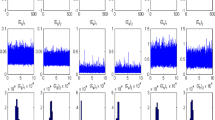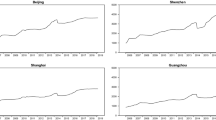Abstract
Previous studies commonly use a linear framework to investigate the long-run equilibrium relationship between the housing and stock markets. The linear approaches may not be appropriate if adjustments from disequilibrium are asymmetric in both markets. Nonlinear adjustments are likely to be observed since the two markets respond rather differently to negative shocks where the stock market is more volatile but price rigidity is found in the housing market. In this paper, we firstly propose two hypotheses on the long-run equilibrium relationship of the US housing and stock markets, and then employ the threshold cointegration model to investigate the potential asymmetric relationships between the two markets. Our empirical results reveal that cointegration exists among the markets, but adjustments toward its long-run equilibrium are asymmetric. Further evidence points out that a rapid mean reversion occurs in one regime where the stock price outperforms the housing price, and no significant reversion is found in the other regime, supporting the hypothesis of the existence of an asymmetric wealth effect among the two markets in the US. Furthermore, evidence from the asymmetric vector error correction model shows that significant error corrections toward the equilibrium exist in the short run only when the stock price exceeds the real estate price by the estimated threshold level, reassuring the finding of the asymmetric wealth effect.

Similar content being viewed by others
Notes
GJR-GARCH model is one kind of T-GARCH model.
Okunev et al. (2002) studied the correlation between the housing and stock markets in Australia from 1980 to 1999 with linear and non-linear Granger causality tests. Results showed that structural changes create unstable linear relationship between the housing and stock markets. The non-linear causality test strongly indicated that the stock market in Australia has a one-way effect on the housing market.
This study used three types of M-TAR models. In the Model 1, residual error did not have serial correlation. In the Model 2, residual error had first-order serial correlation. The Model 3 used the efficient threshold value.
References
Ando, A., & Modigliani, F. (1963). The ‘life cycle’ hypothesis of saving: aggregate implications and tests. American Economic Review, 53(1), 55–84.
Balke, N., & Fomby, T. (1997). Threshold cointegration. International Economic Review, 38(3), 627–645.
Black, F. (1976). Studies of stock price volatility changes. Proceedings of the Meetings of the American Statistical Association, Business and Economics Statistics Division, 177–181.
Brueggeman, W. B., Chen, A. H., & Thibodeau, T. G. (1984). Real estate investment funds: performance and portfolio considerations. Journal of the American Real Estate and Urban Economics Association, 12, 333–354.
Christie, A. (1982). The stochastic behavior of common stock variances: value, leverage, and interest rate effects. Journal of Financial Economics, 10, 407–432.
Duffee, G. R. (1995). Stock returns and volatility. Journal of Financial Economics, 37, 399–420.
Enders, W., & Granger, C. W. J. (1998). Unit root tests and asymmetric adjustment with an example using the term structure of interest rates. Journal of Business and Economic Statistics, 16, 304–311.
Enders, W., & Siklos, P. L. (2001). Cointegration and threshold adjustment. Journal of Business and Economic Statistics, 19, 166–176.
Engle, R. F., & Granger, C. W. J. (1987). Cointegration and error correction: representation, estimation and testing. Econometrica, 55, 251–276.
Figlewski, S., & Wang, X. (2000). Is the “leverage effect” a leverage effect? Working Paper Series.
Genesove, D., & Mayer, C. (2001). Loss aversion and seller behavior: evidence from the housing market. Quarterly Journal of Economics, 116, 1233–1260.
Glascock, J. L. (1991). Market conditions, risk, and real estate portfolio returns: some empirical evidence. Journal of Real Estate Finance and Economics, 4, 367–374.
Glascock, J. L., Michayluk, D., & Neuhauser, K. (2004). The riskiness of REITs surrounding the October 1997 stock market decline. Journal of Real Estate Finance and Economics, 28, 339–354.
Glosten, L. R., Jagannathan, R., & Runkle, D. E. (1993). On the relation between the expected value and the volatility of the nominal excess return on stocks. Journal of Finance, 48, 1779–1801.
Green, R. K. (2002). Stock prices and house prices in California: new evidence of a wealth effect? Regional Science and Urban Economics, 32, 775–783.
Hansen, B., & Seo, B. (2002). Testing for two-regime threshold cointegration in vector error-correction models. Journal of Econometrics, 110, 293–318.
Hartzell, D., Hekman, J. S., & Miles, M. E. (1987). Real estate returns and inflation. The Journal of the American Real Estate and Urban Economics Association, 15, 617–637.
Ibbotson, R. G., & Siegel, L. B. (1984). Real estate returns: a comparison with other investments. AREUEA Journal, 12, 219–242.
Koutmos, G., & Saidi, R. (1995). The leverage effect in individual stocks and the debt to equity ratio. Journal of Business Finance & Accounting, 22, 1063–1075.
Kuhle, J. (1987). Portfolio diversification and returns benefits—common stock vs. real estate investment trusts. Journal of Real Estate Research, 2, 1–9.
Mackinnon, J. (1996). Numerical distribution functions for unit root and cointegration tests. Journal of Applied Econometrics, 11, 601–618.
Markowitz, H. (1952). Portfolio selection. The Journal of Finance, 7(1), 77–91.
Officer, R. R. (1973). The variability of the market factor of the New York stock exchange. The Journal of Business, 46, 434–453.
Okunev, J., Wilson, P., & Zurbruegg, R. (2002). Relationships between Australian real estate and stock market prices: a case of market inefficiency. Journal of Forecasting, 21, 181–192.
Phillips, P. C. B., & Perron, P. (1988). Testing for a unit root in time series regression. Biometrika, 75, 335–346.
Quan, C. D., & Titman, S. (1997). Commercial real estate prices and stock market returns: an international analysis. Financial Analysts Journal, 53(3), 21–34.
Quan, C. D., & Titman, S. (1999). Do real estate prices and stock prices move together? An international analysis. Real Estate Economics, 27, 183–207.
Rubens, J., Bond, M., & Webb, J. (1989). The inflation-hedging effectiveness of real estate. Journal of Real Estate Research, 4, 45–56.
Said, S., & Dickey, D. (1984). Testing for unit roots in autoregressive-moving average model of unknown order. Biometrica, 71, 599–607.
Schwert, W. (1989). Why does stock market volatility change over time? Journal of Finance, 44, 1115–1153.
Shefrin, H., & Statman, M. (1985). The disposition to sell winners too early and ride losers too long: theory and evidence. Journal of Finance, 40, 777–791.
Sim, S.-H., & Chang, B.-K. (2006). Stock and real estate markets in Korea: wealth or credit–price effect. Journal of Economic Research, 11, 99–122.
Tsai, I-C., & Chen, M.-C. (2009). The asymmetric volatility of house price in the UK. Property Management, 27, 80–90.
Worzala, E., & Vandell, K. (1993). International direct real estate investments as alternative portfolio assets for institutional investors: An evaluation. Paper presented at the 1993 AREUEA meetings, Anaheim, CA, USA.
Author information
Authors and Affiliations
Corresponding author
Rights and permissions
About this article
Cite this article
Tsai, IC., Lee, CF. & Chiang, MC. The Asymmetric Wealth Effect in the US Housing and Stock Markets: Evidence from the Threshold Cointegration Model. J Real Estate Finan Econ 45, 1005–1020 (2012). https://doi.org/10.1007/s11146-011-9304-5
Published:
Issue Date:
DOI: https://doi.org/10.1007/s11146-011-9304-5




